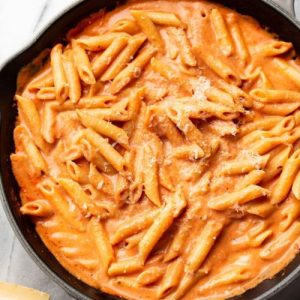
Creamy Tomato Pasta
A quick and delicious creamy tomato pasta made with garlic, tomato sauce, and a touch of cream for a silky finish. Perfect for weeknights, this comforting dish is ready in just 25 minutes and pairs beautifully with freshly grated parmesan.
Equipment
- 1 Large Pot (for pasta)
- 1 Skillet or sauté pan (medium size)
- 1 wooden spoon (for stirring)
- 1 Colander (for draining pasta)
- 1 Chef’s knife & cutting board (for garlic)
- 1 measuring cup & spoons
Ingredients
- 8 oz 225 g pasta, uncooked
- 2 tbsp butter
- 2 –3 cloves garlic minced
- 2 tbsp tomato paste
- 1 can 14 oz / 400 g tomato sauce
- ¾ cup 180 ml heavy cream or whipping cream
- ¼ tsp Italian seasoning
- Salt to taste
- Black pepper to taste
- Freshly grated parmesan cheese for serving
Instructions
- Prepare the Pasta Water: Fill a large pot with water, add a generous pinch of salt (this seasons the pasta from the inside as it cooks), and bring it to a rolling boil.While the water heats up, gather all your ingredients so they’re within reach. This will make the cooking process smooth and stress-free.
- Cook the Pasta: Once the water is boiling, add your pasta and cook it until just al dente (slightly firm to the bite). Follow the package directions for timing, but check a minute early to avoid overcooking. Stir occasionally so the pasta doesn’t stick together. Before draining, reserve about ½ cup of hot pasta water—this starchy liquid is handy for loosening the sauce later if needed. Drain the pasta in a colander and set aside.
- Melt the Butter: While the pasta cooks, place a medium-sized skillet over medium heat and add the butter. Allow it to melt completely until it’s slightly foamy. The butter forms the base of the sauce, adding richness and depth.
- Sauté the Garlic: Once the butter has melted, add the minced garlic. Stir constantly for about 30–60 seconds until the garlic becomes fragrant and slightly golden. Be careful not to let it burn, as burnt garlic will taste bitter and overpower the sauce.
- Incorporate Tomato Paste: Stir in the tomato paste, spreading it out evenly in the pan. Allow it to cook for 1–2 minutes, stirring frequently. This step deepens the tomato flavor, removes raw acidity, and creates a more robust, slightly sweet base for the sauce.
- Add Tomato Sauce and Cream: Pour in the canned tomato sauce followed by the heavy cream. Stir slowly and continuously until both are fully combined into a smooth, pink-hued sauce. At this stage, you’ll notice the sauce becoming creamy and velvety.
- Season the Sauce: Sprinkle in the Italian seasoning and stir again to distribute the herbs evenly. Season generously with salt and black pepper to taste. If the sauce tastes a little sharp or acidic, add a small pinch of sugar to balance it out. Let the sauce cook gently for 4–6 minutes, stirring occasionally, until it thickens slightly and clings to the back of a spoon. Lower the heat if it begins to bubble too vigorously—you want a soft simmer, not a rolling boil.
- Combine Pasta and Sauce: Add the drained pasta directly into the skillet with the creamy tomato sauce. Toss well to ensure each piece of pasta is coated. If the sauce feels too thick, splash in a tablespoon or two of the reserved pasta water and stir until the consistency is silky and smooth.
- Finish with Parmesan: Once the pasta and sauce are perfectly combined, transfer to serving plates or bowls. Grate fresh parmesan cheese generously over the top for a nutty, salty finish. Serve immediately while hot for the best flavor and texture.
Notes
- Use high-quality pasta for best texture; whole wheat or gluten-free options work well.
- Always taste and adjust seasoning as tomato sauces can vary in acidity.
- Reserve some pasta water—it helps loosen the sauce without diluting flavor.
- Heavy cream is essential for creaminess; lower-fat alternatives may curdle when mixed with tomato.
- Garlic can be roasted for a sweeter, milder flavor.
- Parmesan can be added to the sauce while cooking for extra richness.
- Cook pasta al dente to prevent it from becoming mushy when combined with the sauce.
- This dish reheats well, but fresh parmesan on top is best added after reheating.